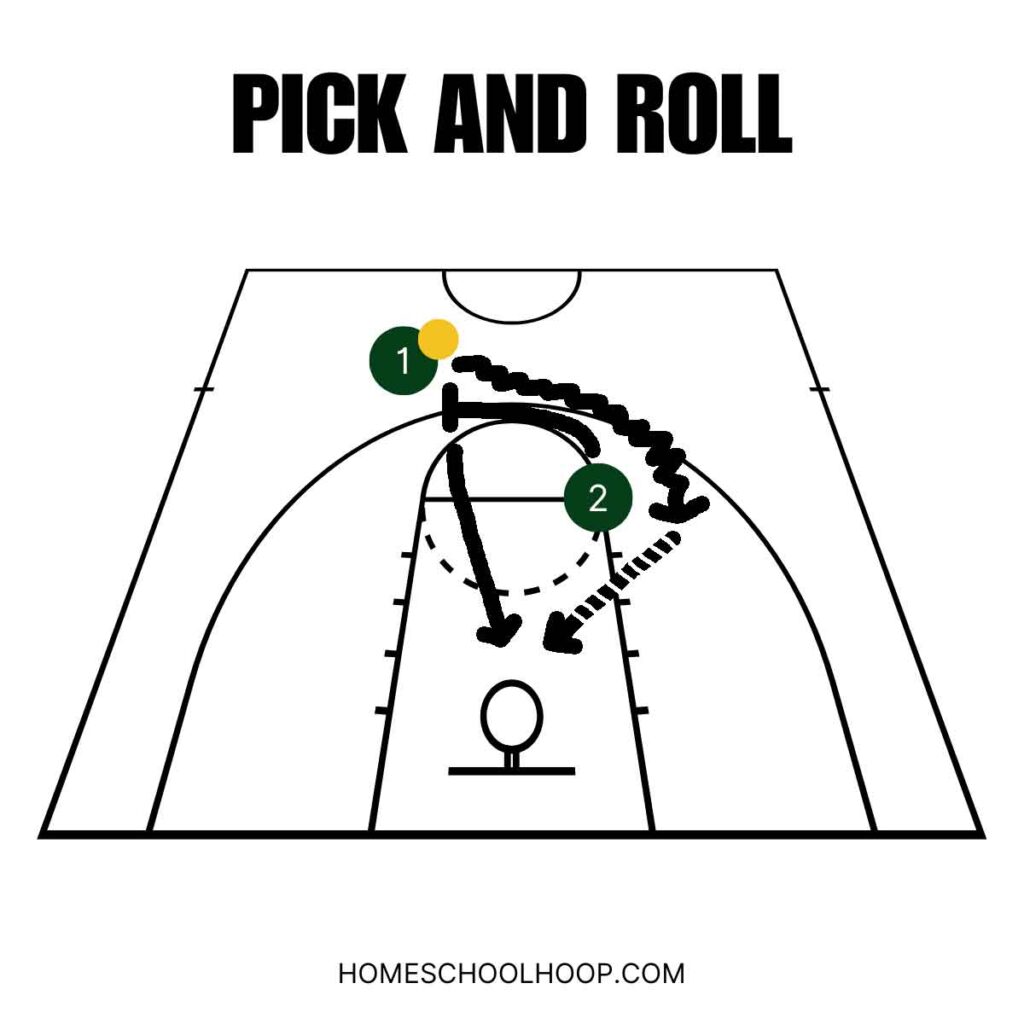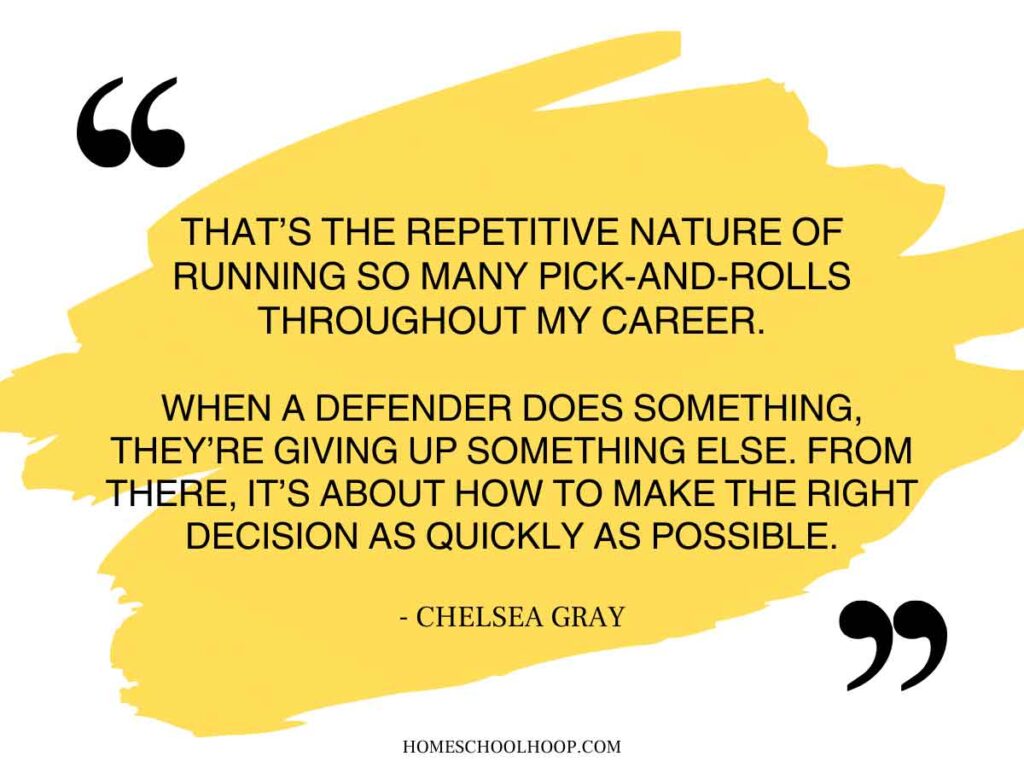The pick and roll is a fundamental offensive tactic that can help a team penetrate to the basket and get open shots. It takes teamwork and skill to pull off, but is arguably the hardest maneuver to guard.
Key Takeaways:
- The pick and roll is an offensive basketball play where one player sets a screen (the pick) for the player with the ball and then moves toward the basket (the roll).
- This play challenges the defense and creates scoring opportunities for the ball handler or the screener.
- Execution involves two players – the ball handler, who uses the screen, and the screener, who sets the pick and then moves strategically.
Here, we break down the pick and roll in simple terms. You’ll learn how to pull off this play effectively, understand the specific roles of the involved players, explore different ways to do it, and see why it’s a tough play for the opposing team to stop.
What is a Pick and Roll in Basketball?
The pick and roll, also known as a screen and roll, is a strategic move in basketball, used frequently by offenses for its effectiveness. Let’s break it down:
- Pick: Pick is another word for screen in basketball. In a pick and roll, a player, usually a forward or center, sets a pick by standing in the path of a defender. This action momentarily blocks or ‘picks’ the defender from following the ball handler.
- Roll: After setting the pick, the same plate moves, or ‘rolls,’ toward the basket to receive a basket and potentially score.

The pick and roll can be a reliable offensive play for scoring and it works in various game situations. While it requires teamwork and communication by the players pulling it off, it’s even harder on the defense. For the defense, it requires precise coordination to counter, often leading to confusion and scoring opportunities.
In the compilation of clips in the video below, you can see how defenders struggle to defend the pick and roll by the Las Vegas Aces.
Purpose of the Pick and Roll
The play opens up scoring opportunities by creating advantageous situations on the court. Here’s why offenses love the pick and roll:
- It forces defenders to choose: The defenders of the screener and the ball-handler executing the pick and roll have to decide who they’re going to prioritize. If they focus on the ball-handler, it can leave the screener open for the roll, and vice-versa.
- It can create mismatches: Oftentimes it forces the defenders to switch players, creating favorite matchups, like a smaller defender guarding a taller player.
- It opens up space: This move can spread the defense out, opening up space on the court for shots or further plays.
- For versatility: The ball-handler can either drive to the basket or pass the ball to an open teammate, depending on how the defense reacts.
TRIVIA:
Which duo is credited for revolutionizing the pick and roll play in the 1980s and 1990s?
Clue 1: This pair played for the Utah Jazz.
Clue 2: One was a point guard, and the other was a power forward.
Clue 3: They are considered one of the best pick-and-roll combinations in NBA history.
Scroll to the bottom for the answer.
Fundamentals of the Pick and Roll
Proper execution of the pick and roll hinges on the seamless interaction between the screener and the ball-handler. Their coordinated effort, powered by effective communication and precise timing, is what makes this play work.
The Role of the Screener
The screener is a pivotal player in the pick and roll. Here’s what they need to do:
1. Set a Solid Screen:
- Position correctly to create a barrier for the defender.
- Stand firm and avoid moving to prevent a foul.
2. Read the Options Post-Screen:
- Roll: Pin the defender and move toward the basket for a potential pass and score.
- Pop: Step back for an open shot, typically used by players good at shooting.
A third option for the screener happens before the screen. If they get into screening position and realize their defender is hedging high in anticipation of the ball-handler, the screener can “slip the screen.” This means that Instead of holding the screen, they cut to the basket for a possible assist from their teammate.
The Role of the Ball-Handler
The ball-handler’s decisions drive the play. Here’s their role in a pick and roll:
1. Utilize the Screen:
- Use the screen effectively to get past the defender.
- If the screener slips, the ball-handler may choose to pass to them rather than drive as originally planned.
2. Decide Where to Go Next:
- Quickly assess the defense’s response to the screen.
- Decide whether to drive towards the basket, pass to the screener who is rolling, or find another open teammate.
NBA player Stephen Curry of the Golden State Warriors is among the best at reading defenders off the pick and roll to get open shots. In the video below, you can see how as the ball-handler he uses the screens from the wing position:
Executing the Pick and Roll: Step-by-Step Guide
1. Set up the screen
A successful pick and roll starts with setting a quality screen. Ideally, this takes place at the side or top of the key, so there’s room for the ball-handler to navigate once they come off the screen.
The screener positions themselves near the defender guarding the ball-handler, at an angle toward the direction the ball-handler wants to go. They have to hold their position while their teammate uses the screen to avoid an illegal screen call.
2. Come off the screen
Once the screen is set, the ball-handler makes their move. They have several options, including:
- Drive: They can use the screen as a shield against their defender and drive toward the basket.
- Shoot: If their defender drifts back in anticipation of going under the screen, the ball-handler can pull up for a shot.
- Pass: If the defense collapses on the drive, they can look to pass to the screener. If another defender comes over to help, they can pass to the open teammate.
3. The screener reacts to the defense
After setting the screen, the screener has several options based on the defense’s response:
- Roll: They can pin the player they’ve screened and roll toward the basket for a potential pass and layup or dunk.
- Pop: If the defense collapses toward the basket, the screener can ‘pop’ out to the perimeter for an open shot.
- Slip: If the defense anticipates the screen, they can ‘slip’ the screen early and move to the open space near the basket.
Variations of the Pick and Roll
The pick and roll has additional variations, some of which we’ve referenced already. The concept remains the same, but each basketball strategy offers different advantages.
Pick and Pop
In the pick and pop:
- After setting the screen, instead of rolling towards the basket, the screener moves away from the defender, typically towards the perimeter.
- This is effective when the screener is a good outside shooter, creating an opportunity for a jump shot.
Side (Wing) Pick and Roll
The side pick and roll involves:
- The play is initiated from the side of the court, like out on the wing, not the top.
- This variation creates more angles and space for the ball-handler to drive and for the screener to either roll to the basket or pop out for a shot.
Double Pick and Roll
The double pick and roll features:
- Two screeners set consecutive screens for the ball-handler, one right after the other.
- This creates multiple options and confuses the defense, as there are more players involved in the play.
Top Pick and Roll
In the top pick and roll:
- The screen is set at the top of the key, usually around the three-point line.
- This central position offers the ball-handler several passing lanes and driving routes, making it a flexible option.
Strategic Considerations and Advanced Tactics
Mastering the pick and roll involves more than just executing the basic steps. It requires an understanding of strategy and the ability to read the defense.
By focusing on these strategic aspects, you can elevate the effectiveness of the pick and roll, turning it from a simple play into a powerful weapon in your team’s offensive arsenal. Here are some coaching tips.
Reading the Defense
Understanding how the defense reacts to a pick and roll is key to exploiting it:
- Switches: Notice if the defenders switch players during the pick and roll. This can create mismatches you can exploit.
- Help Defense: Pay attention to how defenders from other areas of the court respond. They may leave their player to help, opening opportunities for other teammates.
Creating and Exploiting Mismatches
Using the pick and roll to create mismatches is a classic strategy:
- Size Mismatch: If a smaller defender switches onto a bigger player, use the size advantage in the post.
- Speed Mismatch: If a slower defender switches onto a quicker player, use speed and agility to create a scoring opportunity.
Additional Considerations
- Spacing: Ensure good spacing on the court to prevent the defense from easily helping out.
- Timing: The timing of the screen and the subsequent movements should be synchronized for maximum effectiveness.
- Communication: Constant communication between the ball-handler and the screener is vital for adjusting the play on the fly.
Defending the Pick and Roll
Teams incorporate the pick and roll into their offensive strategies because it’s effective and hard to guard. So, let’s imagine you’re tasked with shutting a team’s pick and roll down.
Regardless of the defensive strategies you go with, nothing will work without proper spacing and communication.
Switching
Switching is a common way to try and counter the pick and roll:
- How it works: When the pick is set, the defenders switch players. The player guarding the screener takes the ball-handler, and vice-versa.
- Key elements: Quick communication and understanding between the two defenders is crucial. They have to decisively switch, otherwise, they risk being caught in no-man’s land.
- Risks: One problem with switching a pick and roll is it can create mismatches. If the pick and roll involves a tall post player and a quick guard, you can see how switching can lead to defenders facing players they’re not equipped to guard well.
Drop Coverage
Drop coverage is a strategy most effective against teams that use the pick and roll to drive more than shoot.
- The approach: The defender guarding the screener drops back toward the basket instead of following the ball-handler over the screen
- Objective: This creates a barrier to the rim, forcing the ball-handler to take a less favorite outside shot. It also creates space for the defender guarding the ball-handler to navigate around the screen.
- Risks: Good shooting teams will take advantage of the extra spacing and be happy to shoot uncontested field goal attempts.
Fighting Through Screens
Fighting through the screen is a more aggressive approach:
- Technique: The defender of the ball-handler works to move around the screen quickly, staying with their original player.
- For this to work: The defender of the screener must simultaneously hedge to push the ball-handler’s attack away from the basket so their teammate has enough time to get around the screen.
- Additional benefit: Fighting through the screen can also encourage the screener to shift or lean to make contact, potentially leading to a moving screen foul on the offense.

FAQs
What is a pick and roll?
A pick and roll is a basketball play where one player sets a screen (the pick) for a teammate with the ball and then moves towards the basket (the roll) to receive a pass and potentially score.
Why is a pick and roll so effective?
The pick and roll is effective because it challenges the defense, creates mismatches, and opens up multiple scoring options. It forces defenders to make quick decisions, often leading to advantageous situations for the offense.
Why is a pick and roll hard to defend?
Defending a pick and roll is challenging because it requires precise coordination between defenders. They must decide quickly whether to switch or fight through the screen, all while communicating effectively and maintaining their formation.
Why is a pick and roll called a pick and roll?
The term ‘pick and roll’ comes from the two main actions in the play. ‘Pick’ refers to the screen set by a player to block or ‘pick’ a defender, and ‘roll’ describes the screener’s movement towards the basket after setting the pick.
GIVE US YOUR THOUGHTS
Today, you learned about the pick and roll in basketball.
So we want to know: In your opinion, what’s the key to a successful pick and roll? Is it more about the skills of each player or the way a team communicates and executes the strategy?
Share your thoughts in the comments.
The TRIVIA answer is John Stockton and Karl Malone.

